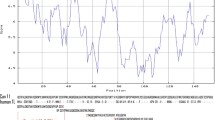Abstract
A human-mouse hybridoma clone 92-2 secreting IgM-class human monoclonal antibody to peanut allergen protein Ara h1 was established. To detect antibody-binding sequences on Ara h1, we synthesized a series of peptides of the Ara h1 protein on a multi-pin apparatus for the pin-peptide ELISA. The 92-2 human monoclonal antibody was found to recognize a sequence of GREGEQEWGTPGSHVREETS. Further analysis with shorter pin-peptides with eight amino acid-long showed that the sequence of QEWGTPGS was an essential linear sequence of this epitope. When the QEW part of the sequence was replaced by alanine, the 92-2 monoclonal antibody did not bind to the substituted peptide, showing that those amino acids play an important role in the binding of the 92-2 monoclonal antibody.




Similar content being viewed by others
References
Burks AW, Williams LW, Helm RM, Connaughton C, Cockrell G, O’Brien T (1991) Identification of a major peanut allergen, Ara h I, in patients with atopic dermatitis and positive peanut challenges. J Allergy Clin Immunol 88:172–179
Burks AW, Cockrell G, Stanley JS, Helm RM, Bannon GA (1995a) Isolation, identification, and characterization of clones encoding antigens responsible for peanut hypersensitivity. Int Arch Allergy Immunol 107:248–250
Burks AW, Cockrell G, Stanley JS, Helm RM, Bannon GA (1995b) Recombinant peanut allergen Ara h I expression and IgE binding in patients with peanut hypersensitivity. J Clin Invest 96:1715–1721. doi:10.1172/JCI118216
Burks AW, Shin D, Cockrell G, Stanley JS, Helm RM, Bannon GA (1997) Mapping and mutational analysis of the IgE-binding epitopes on Ara h 1, a legume vicilin protein and a major allergen in peanut hypersensitivity. Eur J Biochem 245:334–339
Crain MJ, Sanders SK, Butler JL, Cooper MD (1989) Epstein-Barr virus preferentially induces proliferation of primed B cells. J Immunol 143:1543–1548
de Jong EC, Van Zijverden M, Spanhaak S, Koppelman SJ, Pellegrom H, Penninks AH (1998) Identification and partial characterization of multiple major allergens in peanut proteins. Clin Exp Allergy 28:743–751
de Vries JE, Punnonen J, Cocks BG, de Waal Malefyt R, Aversa G (1993) Regulation of the human IgE response by IL4 and IL13. Res Immunol 144:597–601
Hajoui O, Janani R, Tulic M, Joubert P, Ronis T, Hamid Q, Zheng H, Mazer BD (2004) Synthesis of IL-13 by human B lymphocytes: regulation and role in IgE production. J Allergy Clin Immunol 114:657–663
Imamura T, Kanagawa Y, Ebisawa M (2008) A survey of patients with self-reported severe food allergies in Japan. Pediatr Allergy Immunol 19:270–274
Ishizaka K, Ishizaka T (1978) Mechanisms of reaginic hypersensitivity and immunotherapy. Lung 155:3–22
Kajiwara K, Shinazawa M, Morishima H, Yanagihara Y (2004) Differential effect of IL-4 and IL-13 on the expression of recombination-activating genes in mature B cells from human peripheral blood. Cell Immunol 227:121–128
Kanagawa Y, Matsumoto S, Koike S, Imamura T (2009) Association analysis of food allergens. Pediatr Allergy Immunol 20:347–352
Koppelman SJ, Wensing M, Ertmann M, Knulst AC, Knol EF (2004) Relevance of Ara h1, Ara h2 and Ara h3 in peanut-allergic patients, as determined by immunoglobulin E Western blotting, basophil-histamine release and intracutaneous testing: Ara h2 is the most important peanut allergen. Clin Exp Allergy 34:583–590
Maleki SJ, Kopper RA, Shin DS, Park CW, Compadre CM, Sampson H, Burks AW, Bannon GA (2000) Structure of the major peanut allergen Ara h 1 may protect IgE-binding epitopes from degradation. J Immunol 164:5844–5849
Miescher SM, Vogel M (2002) Molecular aspects of allergy. Mol Aspects Med 23:413–462
Naganawa Y, Shinmoto H, Shimmoto M (2005) Generation of mouse-human hybridomas secreting human monoclonal antibodies to Japanese cedar pollen allergen Cry j1. Hum Antibodies 14:27–31
Naganawa Y, Shimmoto M, Maleki SJ, Takase M, Shinmoto H (2008) Epitope analysis of peanut allergen Ara h1 with oligoclonal IgM antibody from human B-lymphoblastoid cells. Cytotechnology 57:177–180. doi:10.1007/s10616-008-9142-3
O’Neill SK, Shlomchik MJ, Glant TT, Cao Y, Doodes PD, Finnegan A (2005) Antigen-specific B cells are required as APCs and autoantibody-producing cells for induction of severe autoimmune arthritis. J Immunol 174:3781–3788
Prussin C, Metcalfe DD (2006) IgE, mast cells, basophils, and eosinophils. J Allergy Clin Immunol 117(Suppl):S450–S456
Shin DS, Compadre CM, Maleki SJ, Kopper RA, Sampson H, Huang SK, Burks AW, Bannon GA (1998) Biochemical and structural analysis of the IgE binding sites on ara h1, an abundant and highly allergenic peanut protein. J Biol Chem 273:13753–13759
Shinmoto H, Dosako S, Tachibana H, Shirahata S, Murakami H (1991) Generation of human-mouse hybridoma secreting human IgM class anti-neocarzinostatin antibody and its application to hybrid hybridoma. Agric Biol Chem 55:2883–2885
Shinmoto H, Dosako S, Tanaka S (1992) Transformation of human colostrum lymphocytes with Epstein-Barr virus. Tokai J Exp Clin Med 17:129–132
Shinmoto H, Naganawa Y, Shimmoto M, Maleki SJ (2004) Generation of mouse-human hybridomas secreting antibodies against peanut allergen Ara h1. Cytotechnology 46:19–23. doi:10.1007/s10616-005-1578-0
Zhu F, Ramadan G, Davies B, Margolis DA, Keever-Taylor CA (2008) Stimulation by means of dendritic cells followed by Epstein-Barr virus-transformed B cells as antigen-presenting cells is more efficient than dendritic cells alone in inducing Aspergillus f16-specific cytotoxic T cell responses. Clin Exp Immunol 151:284–296
Author information
Authors and Affiliations
Corresponding author
Rights and permissions
About this article
Cite this article
Shinmoto, H., Matsuo, Y., Naganawa, Y. et al. Epitope analysis of peanut allergen Ara h1 with human monoclonal IgM antibody 92-2. Cytotechnology 62, 307–311 (2010). https://doi.org/10.1007/s10616-009-9243-7
Received:
Accepted:
Published:
Issue Date:
DOI: https://doi.org/10.1007/s10616-009-9243-7




